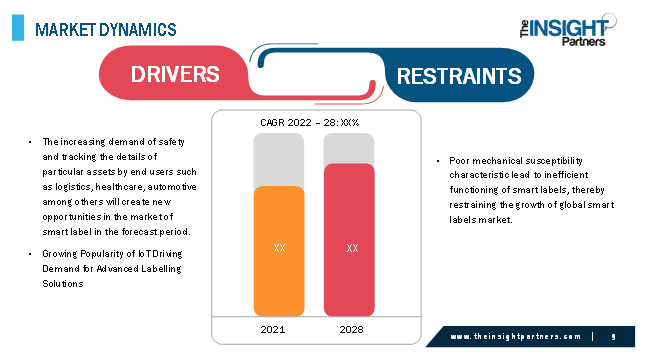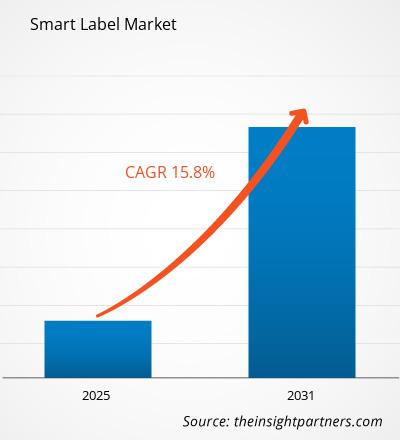市场概览
智能标签用于提供有关以下内容的即时详细信息各种最终用户(例如医疗保健、制造、汽车、物流等)使用的特定产品。这些标签有助于最终用户提供有关产品的实时信息,也可用于检查产品的真实性。智能标签市场的主要驱动力是其可靠性和对产品详细信息的轻松实时跟踪,这将在预测期内推动市场发展。
市场范围和报告特征
我们的“2031 年全球智能标签市场分析”报告概括了详细的市场分析智能标签市场的组件、技术、应用和行业等关键细分市场,以及覆盖五个关键地区和几个国家的地理区域的深入统计和定性分析。作为定性分析的一部分,该报告对主要市场动态进行了评估,例如当前的市场驱动因素、为未来发展铺平道路的主要挑战和机遇。此外,我们对主要竞争对手的分析提供了市场举措、SWOT 分析的战略观点,并突出了参与者的产品和服务发展。
市场细分
全球智能标签市场——按组件
- •收发器•电池•微处理器•回忆
全球智能标签市场 –按技术
- •电子商品防盗标签 (EAS)• RFID 标签•感应标签•电子货架/动态显示标签• 近场通信 (NFC) 标签
全球智能标签市场 –按应用
- •零售库存•电子和 IT 资产•设备•托盘跟踪•其他
全球智能标签市场 –按行业
- •医疗保健•汽车•零售•制造•物流•食品和饮料•其他
市场动态

区域见解
该报告提供了行业的详细概述,包括定性和定量信息。它提供了基于各个细分市场的全球市场的概述和预测。它还提供了 2022 年至 2031 年五个主要地区的市场规模和预测估计,即:北美、欧洲、亚太地区 (APAC)、中东和非洲 (MEA) 以及南美洲。每个地区的智能标签市场随后按各自的国家和细分市场进行细分。报告涵盖了全球18个国家的分析和预测以及该地区的当前趋势和机遇。
该报告从需求和供给两个方面分析了影响市场的因素,并进一步评估了预测期内影响市场的市场动态,即驱动因素、限制因素、机会和未来趋势。该报告还为所有五个地区提供了详尽的 PEST 分析,即:在评估了北美、欧洲、亚太地区、中东和非洲和南美洲影响这些地区智能标签市场的政治、经济、社会和技术因素后。
市场参与者
该报告涵盖了智能标签市场的主要发展,如有机和无机增长战略。许多公司都专注于有机增长战略,例如产品发布、产品批准以及专利和活动等其他战略。市场上见证的无机增长战略活动包括收购、合作伙伴关系和合作伙伴关系。合作。这些活动为扩大市场参与者的业务和客户群铺平了道路。随着全球市场需求的不断增长,智能标签市场的投资者预计未来将获得利润丰厚的增长机会。
该报告还包括智能标签市场主要公司的概况及其 SWOT 分析和市场策略。此外,该报告重点关注行业领先企业,提供公司简介、提供的组件和服务、过去 3 年的财务信息、过去 5 年的关键发展等信息。
- •艾利丹尼森公司•Alien Technology, LLC.•CCL Industries< /span>•Checkpoint Systems, Inc.•霍尼韦尔国际公司•佐藤控股公司•Mühlbauer 集团•东芝公司•斑马技术公司•游戏实验室国际有限责任公司
报告要点
我们的智能标签市场报告涵盖以下关键参数:
- •全球、区域和国家层面的全面市场分析•详细的影响北美、欧洲、亚太地区、中东和非洲等主要地理区域市场的 PEST(政治、经济、社会和技术)因素,以及南美洲。•市场动态(驱动因素、限制因素、机会和未来趋势)以及短期、中期和长期驱动因素和限制因素的影响分析。•市场规模和收入预测;2021 年(历史)、2021 年(基准年)、2022 年 – 28 年(预测期)。•
Insight Partner 的专业研究和分析团队由经验丰富的专业人士组成,拥有先进的统计专业知识,并在现有研究中提供各种定制选项。
- 历史分析(2 年)、基准年、预测(7 年)及复合年增长率
- PEST 和 SWOT 分析
- 市场规模价值/数量 - 全球、区域、国家
- 行业和竞争格局
- Excel 数据集



Report Coverage
Revenue forecast, Company Analysis, Industry landscape, Growth factors, and Trends

Segment Covered
This text is related
to segments covered.

Regional Scope
North America, Europe, Asia Pacific, Middle East & Africa, South & Central America

Country Scope
This text is related
to country scope.
常见问题
Some of the customization options available based on the request are an additional 3–5 company profiles and country-specific analysis of 3–5 countries of your choice. Customizations are to be requested/discussed before making final order confirmation#as our team would review the same and check the feasibility
The report can be delivered in PDF/PPT format; we can also share excel dataset based on the request
Integration with IoT and adoption of blockchain technology are likely to remain a key trend in the market.
Rapid growth of e-commerce and concerns over sustainability are the major factors driving the smart label market.
The Smart Label Market is estimated to witness a CAGR of 15.8% from 2024 to 2031
Trends and growth analysis reports related to Electronics and Semiconductor : READ MORE..
The List of Companies
1. AVERY DENNISON CORPORATION
2. Alien Technology, LLC.
3. CCL Industries
4. Checkpoint Systems, Inc.
5. GLI, LLC
6. Honeywell International Inc.
7. SATO Holdings Corporation
8. Mühlbauer Group
9. Toshiba Corporation
10. Zebra Technologies Corporation
The Insight Partners performs research in 4 major stages: Data Collection & Secondary Research, Primary Research, Data Analysis and Data Triangulation & Final Review.
- Data Collection and Secondary Research:
As a market research and consulting firm operating from a decade, we have published and advised several client across the globe. First step for any study will start with an assessment of currently available data and insights from existing reports. Further, historical and current market information is collected from Investor Presentations, Annual Reports, SEC Filings, etc., and other information related to company’s performance and market positioning are gathered from Paid Databases (Factiva, Hoovers, and Reuters) and various other publications available in public domain.
Several associations trade associates, technical forums, institutes, societies and organization are accessed to gain technical as well as market related insights through their publications such as research papers, blogs and press releases related to the studies are referred to get cues about the market. Further, white papers, journals, magazines, and other news articles published in last 3 years are scrutinized and analyzed to understand the current market trends.
- Primary Research:
The primarily interview analysis comprise of data obtained from industry participants interview and answers to survey questions gathered by in-house primary team.
For primary research, interviews are conducted with industry experts/CEOs/Marketing Managers/VPs/Subject Matter Experts from both demand and supply side to get a 360-degree view of the market. The primary team conducts several interviews based on the complexity of the markets to understand the various market trends and dynamics which makes research more credible and precise.
A typical research interview fulfils the following functions:
- Provides first-hand information on the market size, market trends, growth trends, competitive landscape, and outlook
- Validates and strengthens in-house secondary research findings
- Develops the analysis team’s expertise and market understanding
Primary research involves email interactions and telephone interviews for each market, category, segment, and sub-segment across geographies. The participants who typically take part in such a process include, but are not limited to:
- Industry participants: VPs, business development managers, market intelligence managers and national sales managers
- Outside experts: Valuation experts, research analysts and key opinion leaders specializing in the electronics and semiconductor industry.
Below is the breakup of our primary respondents by company, designation, and region:

Once we receive the confirmation from primary research sources or primary respondents, we finalize the base year market estimation and forecast the data as per the macroeconomic and microeconomic factors assessed during data collection.
- Data Analysis:
Once data is validated through both secondary as well as primary respondents, we finalize the market estimations by hypothesis formulation and factor analysis at regional and country level.
- Macro-Economic Factor Analysis:
We analyse macroeconomic indicators such the gross domestic product (GDP), increase in the demand for goods and services across industries, technological advancement, regional economic growth, governmental policies, the influence of COVID-19, PEST analysis, and other aspects. This analysis aids in setting benchmarks for various nations/regions and approximating market splits. Additionally, the general trend of the aforementioned components aid in determining the market's development possibilities.
- Country Level Data:
Various factors that are especially aligned to the country are taken into account to determine the market size for a certain area and country, including the presence of vendors, such as headquarters and offices, the country's GDP, demand patterns, and industry growth. To comprehend the market dynamics for the nation, a number of growth variables, inhibitors, application areas, and current market trends are researched. The aforementioned elements aid in determining the country's overall market's growth potential.
- Company Profile:
The “Table of Contents” is formulated by listing and analyzing more than 25 - 30 companies operating in the market ecosystem across geographies. However, we profile only 10 companies as a standard practice in our syndicate reports. These 10 companies comprise leading, emerging, and regional players. Nonetheless, our analysis is not restricted to the 10 listed companies, we also analyze other companies present in the market to develop a holistic view and understand the prevailing trends. The “Company Profiles” section in the report covers key facts, business description, products & services, financial information, SWOT analysis, and key developments. The financial information presented is extracted from the annual reports and official documents of the publicly listed companies. Upon collecting the information for the sections of respective companies, we verify them via various primary sources and then compile the data in respective company profiles. The company level information helps us in deriving the base number as well as in forecasting the market size.
- Developing Base Number:
Aggregation of sales statistics (2020-2022) and macro-economic factor, and other secondary and primary research insights are utilized to arrive at base number and related market shares for 2022. The data gaps are identified in this step and relevant market data is analyzed, collected from paid primary interviews or databases. On finalizing the base year market size, forecasts are developed on the basis of macro-economic, industry and market growth factors and company level analysis.
- Data Triangulation and Final Review:
The market findings and base year market size calculations are validated from supply as well as demand side. Demand side validations are based on macro-economic factor analysis and benchmarks for respective regions and countries. In case of supply side validations, revenues of major companies are estimated (in case not available) based on industry benchmark, approximate number of employees, product portfolio, and primary interviews revenues are gathered. Further revenue from target product/service segment is assessed to avoid overshooting of market statistics. In case of heavy deviations between supply and demand side values, all thes steps are repeated to achieve synchronization.
We follow an iterative model, wherein we share our research findings with Subject Matter Experts (SME’s) and Key Opinion Leaders (KOLs) until consensus view of the market is not formulated – this model negates any drastic deviation in the opinions of experts. Only validated and universally acceptable research findings are quoted in our reports.
We have important check points that we use to validate our research findings – which we call – data triangulation, where we validate the information, we generate from secondary sources with primary interviews and then we re-validate with our internal data bases and Subject matter experts. This comprehensive model enables us to deliver high quality, reliable data in shortest possible time.

 获取此报告的免费样本
获取此报告的免费样本